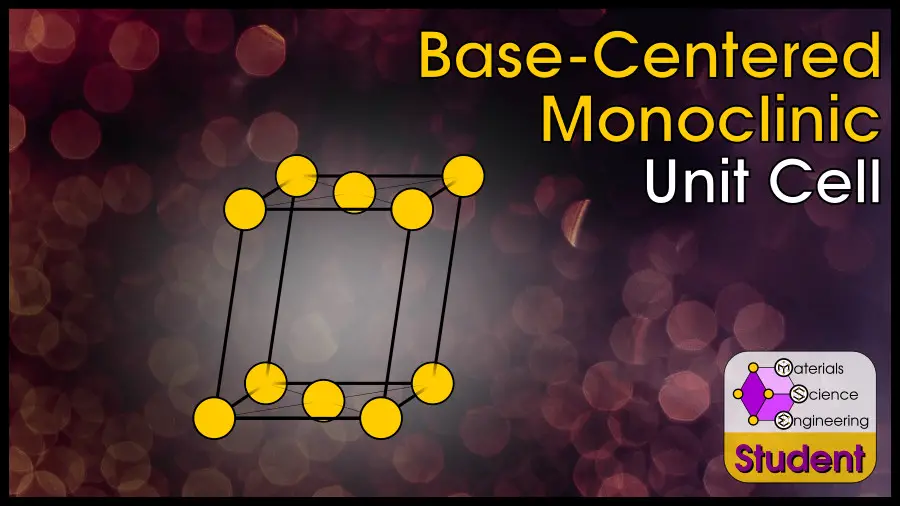
The monoclinic unit cell has three lattice parameters a, b, and c that each have different lengths; two vector angles α and γ are at 90º to each other, and the third vector angle β is not. “Base-centering” adds an additional atom to the top and bottom.
Since base-centered monoclinic is one of the less-common crystal structures, I’m assuming someone searching for this is a somewhat advanced student in materials science, so I’ll give you the facts quickly and with little explanation. If you are new to materials science and don’t know what something means, you can check out my articles on the FCC, BCC, or HCP crystals, which explain terminology more slowly.
As far as I know, there are no real-world materials that exhibit a base-centered monoclinic unit cell. If this structure were to exist, it would be a box with 3 different side lengths, with an atom on each corner and in the center of two opposite faces. There are “base-centered monoclinic” crystals based on the Bravais lattice, which exist with multiple atoms that overall displays base-centered monoclinic symmetry.
The base-centered monoclinic unit cell would belong to space group #12 or C2/m, with Pearson symbol mC2. There is no prototype or Strukturbericht for base-centered monoclinic, since it does not exist with real atoms.
The base-centered monoclinic unit cell can be imagined as a tilted box with 3 different side lengths, with an atom on each corner and at the center of the top and bottom faces. Pure materials never take this crystal structure, and it exists only mathematically. Base-centered monoclinic has 2 atoms per unit cell, lattice constants a, b, and c, lattice angles α=γ= 90º and β ≠ 90, Coordination Number CN=4, and Atomic Packing Factor .
Outline
Common Examples of Base-Centered Monoclinic Materials
None.
However, there are still materials with a multi-atom basis that have a base-centered monoclinic Bravais lattice, such as α-O2, CuO, and β-Pu.
Base-Centered Monoclinic Coordination Number
You can think of monoclinic as a tilt-distortion of the orthorhombic crystal. Base-centering adds an atom to the top and bottom faces (similar to face-centering, but face-centering adds an atom to every face). For the top and bottom faces, which are rectangles, there are 4 nearest neighbors int the base-centered monoclinic cell.
Base-Centered Monoclinic Lattice Constants
The monoclinic lattice has 4 parameters: lattice length a, b, and c; and lattice angle β. The other two lattice angles, α and γ, are always equal to 90º. There’s no real reason that the non-90º angle is defined as β; that’s just convention.
If we try to stay within the hard sphere model, we see that the close packed direction would be along the top or bottom face diagonal. If the atoms touched in that direction, half of the face diagonal length would be , and the lattice parameter lengths would need to fit the 2D distance formula
.
If you wanted to describe the base-centered monoclinic cell with primitive vectors, they would be:
Base-Centered Monoclinic Atomic Packing Factor
There is no simple answer for the base-centered monoclinic APF, because the answer changes depending on the side lengths.
The volume of a monoclinic unit cell is , obtained by multiplying the square area of the base (
) by the height of a cell. Since the c edge is NOT perpendicular to the base, we need to calculate the sine of the tilt angle (beta). Hence, the height of a cell equals
.
There is 1 atom split between each of the 8 corners of the cell, and another half atom at the top and bottom, so the total is two full atoms with a spherical radius of .
This allows us to write the theoretical APF in terms of the atomic radius and lattice constants.
Final Thoughts
The base-centered monoclinic crystal structure does NOT exist in real life, and only arises by mathematical definition. There are many crystals which have a base-centered monoclinic Bravais lattice, but these crystals have a more complicated “basis” which leads to its characteristic asymmetrical lattice parameters.
References and Further Reading
If you want to know more about the basics of crystallography, check out this article.
IIf you weren’t sure about the difference between crystal structure and Bravais lattice, check out this article.
I also mentioned atomic packing factor (APF) earlier in this article. This is an important concept in your introductory materials science class, so if you want a full explanation of APF, check out this page.
If you’re interested in advanced crystallography or crystallography databases, you may want to check out the AFLOW crystallographic library.
For a great reference for all crystal structures, check out “The AFLOW Library of Crystallographic Prototypes.”
The 14 Basic Crystal Structures
If you want to learn about specific crystal structures, here is a list of my articles about Bravais lattices and some related crystal structures for pure elements. Base-Centered Monoclinic is one of these 14 Bravais lattices and also occurs as a crystal structure.
1. Simple Cubic
2. Face-Centered Cubic
2a. Diamond Cubic
3. Body-Centered Cubic
4. Simple Hexagonal
4a. Hexagonal Close-Packed
4b. Double Hexagonal Close-Packed (La-type)
5. Rhombohedral
5a. Rhombohedral Close-Packed (Sm-type)
6. Simple Tetragonal
7. Body-Centered Tetragonal
7a. Diamond Tetragonal (White Tin)
8. Simple Orthorhombic
9. Base-Centered Orthorhombic
10. Face-Centered Orthorhombic
11. Body-Centered Orthorhombic
12. Simple Monoclinic
13. Base-Centered Monoclinic
14. Triclinic
Other articles in my crystallography series include:
Introduction to Bravais Lattices
What is the Difference Between “Crystal Structure” and “Bravais Lattice”
Atomic Packing Factor
How to Read Miller Indices
How to Read Hexagonal Miller-Bravais Indices
Close-Packed Crystals and Stacking Order
Interstitial Sites
Primitive Cells
How to Read Crystallography Notation
What are Point Groups
List of Point Groups
What are Space Groups
List of Space Groups
The 7 Crystal Systems